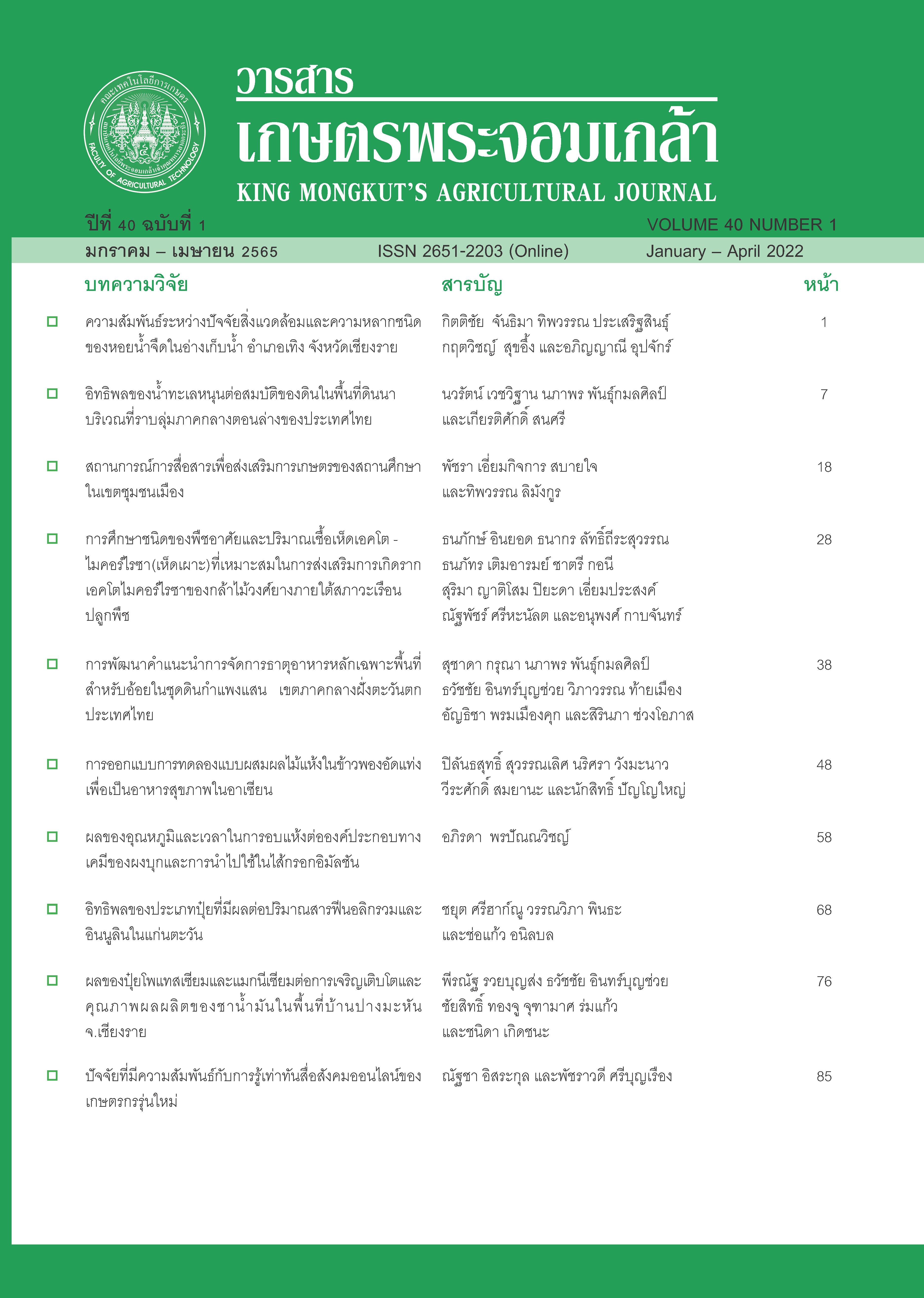Effect of Temperature and Time of Drying Process on Chemical Quality of Konjac Powder and its Application in Sausage Emulsion
Main Article Content
Abstract
Konjac is a dietary plant with high fiber content, low Glycemic Index value and perceived health benefits. Nowadays, consumers are encouraged to select foods that are high in fiber and low in fat, and thus, konjac is an interesting local ingredient to use in a process and thereby gain benefit as a healthy food. The purpose of this research was to study the optimal temperature and drying time of konjac powder, and to apply the powder to food. The drying temperature and time were as follows: 1) 65 °C for 4 hours, 2) 65 °C for 5 hours, 3) 75 °C for 4 hours, and 4) 75 °C for 5 hours. We found that drying the plant at a temperature at 65 °C for 5 hours produced the highest fiber and protein content. The product exhibited moisture content of 7.66%, fat 1.02%, protein 8.54%, carbohydrate 76.90%, and fiber 5.40%. The fat in chicken sausage mixture was replaced with konjac gel in experimental 4 variations: 1) lard 23% (control formula, zero konjac), 2) lard 18% per konjac gel 5%, 3) lard 13% per konjac gel 10%, and 4) lard 8% per konjac gel 15%. The chicken sausage recipe using 13% lard with 10% konjac gel was no different in terms of texture and color values from the control formula. The product had shear force 1,114 grams, springiness 0.84 and cohesiveness of 0.39. Moreover, Fiber and protein content was higher than the control formula but fat content was less. This chicken sausage contained fiber 6.40%, fat 13.34%, and protein 18.91%. In addition, the product quality was within the Thai Industrial Standard of chicken sausage (TIS331/2012). This study indicates a potential avenue for expanding the utilization of konjac as a healthy food supplement.
Article Details

This work is licensed under a Creative Commons Attribution-NonCommercial-NoDerivatives 4.0 International License.
King Mongkut's Agricultural Journal
References
ฉวีวรรณ พันธุ์ไชยศรี, อุมาพร ศิริพินทุ์ และวิจิตรา แดงปรก. 2547. การผลิตกุนเชียงไขมันต่ำจากบุก. เชียงใหม่: ภาควิชาเทคโนโลยีทางอาหาร
คณะวิศวกรรมและอุตสาหกรรมเกษตร มหาวิทยาลัยแม่โจ้ เชียงใหม่.
ถาวร จันทโชติ. 2561. ผลของการเติมคาราจีแนนต่อคุณสมบัติทางกายภาพ-เคมี และประสาทสัมผัสของไส้กรอกไก่ไขมันต่ำ. วารสารวิชาการพระจอม
เกล้าพระนครเหนือ 28(3): 605-616.
นิธิยา รัตนาปนนท์. 2557. เคมีอาหาร. พิมพ์ครั้งที่ 5. กรุงเทพฯ: สำนักพิมพ์โอเดียนสโตร์.
นิสานารถ กระแสร์ชล, พรนภา น้อยพันธ์, พีระภัทร ชะอุ่มเครือ, สุมาลี เสือเถื่อน, เอมมิกา นวลใย และอรรถพล วิเศษลา. 2558. ผลของเจลบุกและ
อุณหภูมิการเซตตัวต่อคุณภาพของไส้กรอกปลาลดไขมันที่ทำจากซูริมิ. คลังความรู้ดิจิทัล มหาวิทยาลัยเกษตรศาสตร์. http://annualconference.ku.ac.th/cd53/04_019_P72.pdf (14 เมษายน 2564).
บุณฑริกา ยืนยง. 2543. การใช้แป้งบุกเพื่อการผลิตแผ่นฟิล์มบริโภค. วิทยานิพนธ์วิทยาศาสตรมหาบัณฑิต สาขาวิชาเทคโนโลยีอาหาร
มหาวิทยาลัยสงขลานครินทร์.
วิชมณี ยืนยงพุทธกาล, สันทัด วิเชียร โชติ, วัชรี บุญถนอม และสุรางค์ ทองสุวรรณ์. 2561. ผลของสภาวะการสกัดต่อคุณภาพของเส้นใยอาหารผงจาก
กากมะตูม. วารสารวิทยาศาสตร์และเทคโนโลยี มหาวิทยาลัยอุบลราชธานี 20(3): 110-123.
วุฒินันท์ โนนลำดวน, ณัฐพล ภูมิสะอาด, ละมุล วิเศษ และชาลีดา บรมพิชัยชาติกุล. 2556. การศึกษาสภาวะที่เหมาะสมที่สุดในการทำแห้งแป้งบุกด้วยวิธีการออกแบบการทดลองแบบพื้นผิวตอบสนอง และการออกแบบส่วนผสมกลาง. วารสารวิชาการวิศวกรรมศาสตร์ ม.อบ. 6(2): 55-63.
ศูนย์วิจัยและพัฒนาผลิตภัณฑ์ปศุสัตว์เชียงใหม่. 2561. การแปรรูปเนื้อสุกรสำหรับผลิตภัณฑ์ยุโรป. เชียงใหม่: กองผลิตภัณฑ์ปศุสัตว์.
สํานักงานมาตรฐานผลิตภัณฑ์อุตสาหกรรม. 2549. มาตรฐานผลิตภัณฑ์ชุมชนแป้งบุก มผช. 1171/2549. กรุงเทพฯ: กระทรวงอุตสาหกรรม.
สํานักงานมาตรฐานผลิตภัณฑ์อุตสาหกรรม. 2555. มาตรฐานผลิตภัณฑ์ชุมชนไส้กรอกไก่ มผช. 331/2555. กรุงเทพฯ: กระทรวงอุตสาหกรรม.
ศุภิสรา พิสุทธิโกศล, พัชรพร จิรแพศยสุข และวรางคณา สมพงษ์. 2561. การผลิตลูกชิ้นปลาเสริมเจลบุกและสมุนไพร. Thai Science and Technology
Journal 26(2): 224-235.
หยาดรุ้ง สุวรรณรัตน์ และจิรพร สวัสดิการ. 2561. ปริมาณใยอาหารและคุณสมบัติการต้านแบคทีเรียของใยอาหารจากเปลือกทุเรียนที่ผ่านการทำแห้ง
แบบลมร้อนและแบบแช่เยือกแข็ง. วารสารวิจัยรำไพพรรณี 12(1): 178-185.
Akesowan, A. 2013. Quality of light pork sausages containing konjac flour improved by texturizing ingredients. Journal of Animal and
Plant Sciences 23(4): 1012-1018.
AOAC. 2000. Official methods of analysis of AOAC international. 17th ed. Verginia, USA: Association of Official Analysis Chemists.
Atashkar, M., Hojjatoleslamy, M., and Sedaghat, B. L. 2018. The influence of fat substitution with K-carrageenan, konjac, and
tragacanth on the textural properties of low-fat sausage. Food Science & Nutrition 6(4): 1015-1022.
Bui, C. V., Siriwatwechakul, W., Tiyabhorn, W., Wattanasiritham, T., Limpraditthanont, N., and Boonyarattanakalin, S. 2016. Conversion of
konjac powder into glucomannan-oligosaccharides, mannose, and glucose by hydrolysis facilitated by microwave heating and
HCl catalyst. The Journal of Industrial Technology 12(2): 45-61.
Chin, K. B., Keeton, J. T., Miller, R. K., Longnecker, M. T., and Lamkey, J. W. 2000. Evaluation of konjac blends and soy protein isolate as fat replacements in low-fat bologna. Journal of Food Science 65(5): 756-763.
Colmenero, F. J. 1996. Technologies for developing low-fat meat products. Trends in Food Science & Technology 7(2): 41-48.
Crehan, C. M., Hughes, E., Troy, D. J., and Buckley, D. J. 2000. Effects of fat level and maltodextrin on the functional properties of
frankfurters formulated with 5, 12 and 30% fat. Meat Science 55(4): 463-469.
Fahimeh, S., Khadijeh, A., Karimian, K. N., Hedayat, H., and Mojtaba, J. 2019. Optimisation of functional sausage formulation with konjac
and inulin: using D-Optimal mixture design. Foods and Raw Materials 7(1): 177-184.
Jian, W., Wu, H., Wu, L., Wu, Y., Jia, L., Pang, J., and Sun, Y. M. 2016. Effect of molecular characteristics of Konjac glucomannan on gelling and rheological properties of Tilapia myofibrillar protein. Carbohydrate Polymers 150: 21-31.
Kim, D. H., Shin, D. M., Seo, H. G., and Han, S. G. 2019. Effects of konjac gel with vegetable powders as fat replacers in frankfurter-type
sausage. Asian-Australasian Journal of Animal Sciences 32(8): 1195-1204.
Osburn, W. N., and Keeton, J. T. 2004. Evaluation of low-fat sausage containing desinewed lamb and konjac gel. Meat Science 68(2):
-233.
Salcedo-Sandoval, L., Ruiz-Capillas, C., Cofrades, S., Triki, M., and Jiménez-Colmenero, F. 2015. Shelf-life of n-3 PUFA enriched frankfurters formulated with a konjac-based oil bulking agent. LWT-Food Science and Technology 62(1): 711-717.
Wei, X., Pang, J., Zhang, C., Yu, C., Chen, H., and Xie, B. 2015. Structure and properties of moisture-resistant konjac glucomannan films
coated with shellac/stearic acid coating. Carbohydrate Polymers 118: 119-125.
Zeng, Z., Chen, M., Wang, X., Wu, W., Zheng, Z., Hu, Z., and Ma, B. 2020. Modeling and optimization for konjac vacuum drying based on
response surface methodology (RSM) and artificial neural network (ANN). Processes 8(11): 1430-1447.
Zhang, C., and Yang, F. Q. 2014. Konjac glucomannan, a promising polysaccharide for OCDDS. Carbohydrate Polymers 104: 175-181.
Zhao, J., Zhang, D., Srzednicki, G., Kanlayanarat, S., and Borompichaichartkul, C. 2010. Development of a low-cost two-stage technique
for production of low-sulphur purified konjac flour. International Food Research Journal 17(4): 1113-1124.


